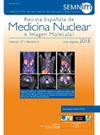Estado del arte y perspectivas futuras de nuevos radionúclidos en Medicina Nuclear: Parte II
IF 1.6
4区 医学
Q3 RADIOLOGY, NUCLEAR MEDICINE & MEDICAL IMAGING
Revista Espanola De Medicina Nuclear E Imagen Molecular
Pub Date : 2025-04-05
DOI:10.1016/j.remn.2025.500128
引用次数: 0
Abstract
The state of the art and future perspectives of new radionuclides in Nuclear Medicine continue to evolve, driven by the development of isotopes with innovative applications in theragnostics.
In this second part of the continuing education series, the clinical and therapeutic applications of terbium, actinium, and bismuth are analyzed in depth. The use of the 4 terbium isotopes (terbium-149, terbium-152, terbium-155, and terbium-161) is described, offering a versatile system for both diagnosis and treatment due to their chemical similarity to lutetium-177, along with the challenges related to their production and availability. Additionally, actinium-225, a powerful alpha-emitting radionuclide, is reviewed for its growing role in targeted alpha therapy, particularly in prostate cancer and neuroendocrine tumors. Finally, bismuth-213, derived from actinium-225, is analyzed for its short half-life, making it a viable option for localized and selective therapies.
Despite technical and production challenges, these radionuclides are driving the evolution of precision medicine, expanding therapeutic and diagnostic possibilities in Nuclear Medicine.
核医学中新型放射性核素的现状和未来前景:第二部分
由于在诊断学中具有创新应用的同位素的发展,核医学中新放射性核素的技术现状和未来前景继续发展。在继续教育系列的第二部分,深入分析了铽、锕和铋的临床和治疗应用。描述了4种铽同位素(terium -149、terium -152、terium -155和terium -161)的使用,由于它们与lutetium-177的化学相似性,以及与它们的生产和可用性相关的挑战,为诊断和治疗提供了一个通用的系统。此外,锕-225是一种强大的α释放放射性核素,它在靶向α治疗中的作用越来越大,特别是在前列腺癌和神经内分泌肿瘤中。最后,铋-213,衍生自锕-225,分析其半衰期短,使其成为局部和选择性治疗的可行选择。尽管存在技术和生产方面的挑战,但这些放射性核素正在推动精准医学的发展,扩大了核医学的治疗和诊断可能性。
本文章由计算机程序翻译,如有差异,请以英文原文为准。
求助全文
约1分钟内获得全文
求助全文
来源期刊

Revista Espanola De Medicina Nuclear E Imagen Molecular
RADIOLOGY, NUCLEAR MEDICINE & MEDICAL IMAGING-
CiteScore
1.10
自引率
16.70%
发文量
85
审稿时长
24 days
期刊介绍:
The Revista Española de Medicina Nuclear e Imagen Molecular (Spanish Journal of Nuclear Medicine and Molecular Imaging), was founded in 1982, and is the official journal of the Spanish Society of Nuclear Medicine and Molecular Imaging, which has more than 700 members.
The Journal, which publishes 6 regular issues per year, has the promotion of research and continuing education in all fields of Nuclear Medicine as its main aim. For this, its principal sections are Originals, Clinical Notes, Images of Interest, and Special Collaboration articles.
 求助内容:
求助内容: 应助结果提醒方式:
应助结果提醒方式:


